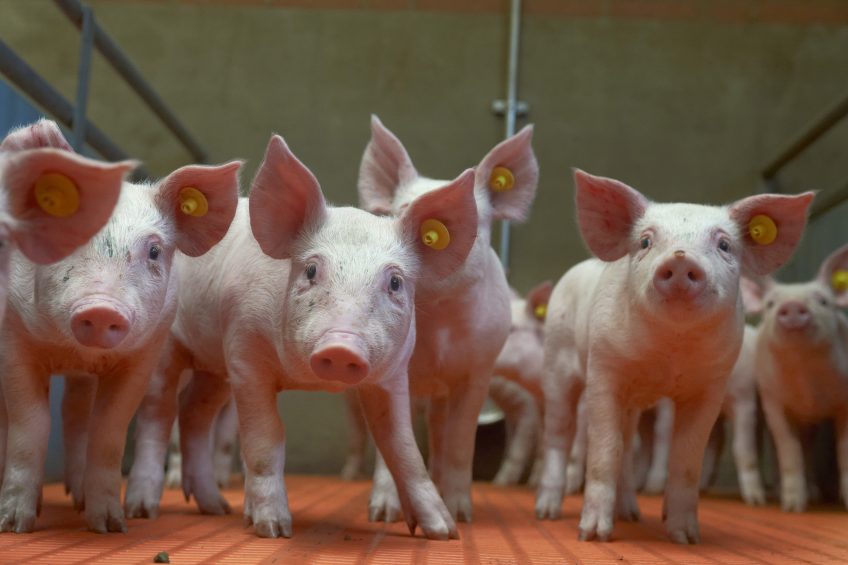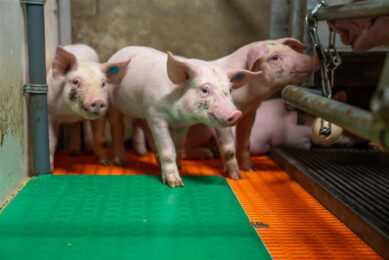Zinc oxide ban: An alternative plan?

For environmental reasons, the European Union has embarked on a process that may lead to a serious reduction of zinc oxide limits for just-weaned piglets. But is that really necessary? In combination with superdosing of phytase, perhaps limits don’t have to come down that much at all.
A frequent question from European Union (EU) pig producers over the last decade has been ‘When will zinc oxide (ZnO) be banned’? Despite the tangible fear among pig producers that it might happen anytime soon, the proposed ban by the Committee for Medicinal Products for Veterinary use (CVMP) in December 2016 seems to have caught everyone by surprise. This ban is based on a new assessment of the evidence that the use of zinc oxide at medicinal levels poses an unacceptable environmental risk. So if zinc oxide usage has to be reduced, is banning medicinal use the only option or are there alternatives?
This article looks at the current situation, the potential impact of the proposal to stop medicinal use of zinc oxide for environmental reasons and finally an alternative solution that may allow for the continued use of zinc oxide as a medicinal product and all the benefits that it can bring while still achieving lower zinc use through the lifetime of the pig.
Current situation
In most EU member states zinc oxide is licensed as a medicinal product for use at 3.1 kg/t feed to provide 2,500 mg/kg zinc for 14 days post-weaning. It is licensed for the treatment and control of post-weaning diarrhoea and its widespread use as a prescription only medicine (POM) shows the effectiveness it continues to have in controlling this common post-wean challenge. Although the mechanism by which zinc oxide elicits this effect is still poorly understood, its link to maintaining tight junction integrity indicates its importance in supporting gut health.
The effectiveness of zinc oxide in controlling post-weaning diarrhoea becomes even more critical as it is playing a significant role in reducing in-feed antibiotic use in pig production. For example, data from one major UK starter feed manufacturer shows veterinary prescriptions for antibiotics in combination with zinc oxide at medicinal levels have shown a significant decline; falling from 61% of all UK feed manufactured at the beginning of 2016 to 37% in December 2016. In contrast, there has been an increase in zinc-oxide only POMs from 26 to 40% of all feeds manufactured over the same time period.
Antibiotic-only POMs have remained unchanged at 3.5%. This change in prescription-only medicines associated with antibiotics clearly demonstrates the importance zinc oxide has had in allowing for this rapid reduction in antibiotic use in starter feeds.
Any removal of medicinal uses of zinc oxide may well slow down, if not reverse, the reduction of antibiotic use currently seen as the key focus within the pig industry as the best way of reducing the potential, although limited, risk of antimicrobial resistance.
Typical zinc consumption of a pig
In the current situation and based on a typical feeding programme with zinc fed at 2,500 mg/kg for 14 days post-weaning followed by feed legislation levels (150 mg/kg to 30 kg, 120 mg/kg from 30 kg to slaughter), a pig would be expected to consume approximately 40 g zinc from wean to finish (see Table 1).
Following new environmental concerns around zinc, a proposal was made by the CVMP in December 2016, to withdraw the medicinal use of zinc oxide. This will in effect reduce maximum dietary zinc levels from 2,500 to 150 mg/kg from weaning to 14 days post-weaning. This would reduce the amount of zinc consumed from wean-to-finish pig by 23%; a reduction from 40 g to 31 g per pig.
This assumes that there is no impact on performance from the removal of zinc oxide at the medicinal level but it could be speculated that the withdrawal of zinc oxide could have a negative effect on pig welfare through an increased level of disease challenge. Hence, any increase in diarrhoea, morbidity or mortality associated with the removal of zinc oxide would reduce growth and feed efficiency thereby increasing the amount of zinc intake from wean to finish and per kg pork produced. This would have a negative economic impact on pig production as well as resulting in the unintended consequence of increased reliance on antibiotics to control post-weaning diarrhoea. We should not ignore challenges to pig welfare from decreased zinc oxide usage.
By not taking into account this potential higher zinc intake, associated with a higher disease challenge, the targeted expected zinc reduction of around 23% less per finished pig may well not be met and so an alternative solution could be to potentially use zinc oxide at levels that helps maintain pig welfare while still targeting lower levels of zinc intake.
An alternative proposal
During the last 15 years since the withdrawal and subsequent reinstatement of zinc oxide in most EU countries there has been pressure on the medicinal use of zinc oxide in pig production post-weaning. Heightened concerns that zinc oxide may be banned led AB Vista and Primary Diets to work together to look at technical opportunities to voluntarily reduce the need for high medicinal zinc oxide use in piglet starter feeds.
This led to the discovery that zinc utilisation could be improved by phytate destruction through superdosing levels of phytase, allowing for lower medicinal zinc oxide levels. This partnership between producer, veterinarian and starter feed supplier has led to a fall in zinc oxide usage from an average of 2.93 kg/t in Sep-Dec 2013 to 2.54 kg/t in Sep-Dec 2016, equating to a -14% reduction, whilst maintaining full efficacy.
This background work supports an alternative proposal that may allow for medicinal use of zinc oxide to be maintained while also meeting the needs of EU member states to reduce zinc intake to meet any environmental considerations. This alternative proposal is 1,500 mg/kg zinc from wean to 14 days, 120 mg/kg until 30 kg, and 100 mg/kg from 30 kg to slaughter (20 mg/kg reduction from current practice) which gives an estimated 23% zinc intake reduction from the current programme today. This would achieve the same target as set out by the CVMP in their December proposal while still allowing for effective medicinal zinc oxide to be used from wean to day 14.
Phytase
How can this reduction in zinc be achieved through superdosing phytase without negatively effecting performance? Research over the last four years has looked at this potential issue of reduced zinc levels and one key finding of that research is the impact that phytase can have on zinc utilisation at pharmacological and at feed levels.
It has been established through the published literature that phytate has the potential to bind zinc at a pH 4 to 6, reducing the effectiveness of zinc oxide in the diet. A novel approach to zinc reduction is now open to EU member states through the destruction of phytate with high levels or superdosing levels of phytase without negatively effecting performance. This application has been well studied and shows that typically in the presence of superdosing phytase, the level of zinc from zinc oxide can be reduced from 2,500 mg/kg to 1,750 mg/kg without having a negative effect on performance as measured by gain and FCR (Table 2). Furthermore, the data have shown that superdosing phytase lowers the level of post-weaning diarrhoea which is attributed to the increased effectiveness of zinc oxide due to the lower levels of dietary phytate attained with the use of superdosing phytase.
Reductions in dietary zinc levels?
The effect of dietary phytate on zinc utilisation in the animal may also play a role in setting dietary zinc levels. With phytase (e.g. 500 FTU/kg) being included in 90% of all feeds manufactured, the extra release of zinc associated with the use of phytase could be taken into account when deciding zinc levels in these diets.
For example, research showed that the use of a microbial phytase at a standard 500 FTU/kg in pigs can release native zinc from plant feedstuffs of between 11 and 34 mg/kg depending on dietary phytate concentration. Hence the reduction in dietary zinc both in late nursery and finisher in the presence of phytase may be achievable without a negative effect on performance and warrants further investigation as part of an overall wean to finisher proposal to reduce zinc intake per pig while maintaining medicinal levels post-weaning at 1,500 mg/kg.
Big opportunity
This research has opened up the opportunity of maintaining or improving post-weaning pig performance while lowering pharmacological levels of dietary zinc oxide to 1,500 mg/kg. Indeed this concept has already been exploited by a number of veterinary surgeons working with swine companies that are looking at the prudent and responsible use of zinc oxide in starter diets as outlined earlier. Increasingly feed companies and veterinarians are working together to balance the key role that medicinal levels of zinc oxide has in terms of growth performance and health with the ability to lower zinc levels with phytase superdosing to mitigate environmental concerns.
Is this a potential solution whereby pig health and welfare can be maintained, environmental concerns are met, and all parties involved meet their target goals? It looks like it.











